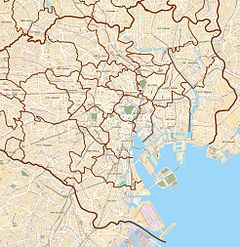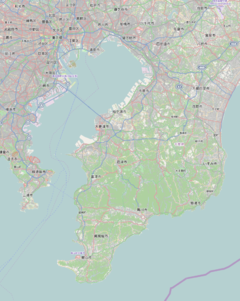Hiroo Station (広尾駅, Hiroo-eki) (officially Hiro-o Station) is a subway station on the Hibiya Line in Minato, Tokyo operated by the Tokyo subway operator Tokyo Metro. The station is named after the adjacent Hiroo neighborhood in Shibuya ward, though the station is entirely located in Minami-Azabu.
H03 Hiroo Station 広尾駅 | ||||||||||||||||
|---|---|---|---|---|---|---|---|---|---|---|---|---|---|---|---|---|
 Hiroo station entrance 2 in 2021 | ||||||||||||||||
| Japanese name | ||||||||||||||||
| Shinjitai | 広尾駅 | |||||||||||||||
| Kyūjitai | 廣尾驛 | |||||||||||||||
| Hiragana | ひろおえき | |||||||||||||||
| General information | ||||||||||||||||
| Location | 5-1-25 Minami-Azabu District, Minato City, Tokyo Japan | |||||||||||||||
| Coordinates | 35°39′08″N 139°43′20″E / 35.652188°N 139.722227°E | |||||||||||||||
| Operated by | ||||||||||||||||
| Line(s) | H Hibiya Line | |||||||||||||||
| Distance | 17.8 km (11.1 mi) from Kita-Senju | |||||||||||||||
| Platforms | 2 side platforms | |||||||||||||||
| Tracks | 2 | |||||||||||||||
| Construction | ||||||||||||||||
| Structure type | Underground | |||||||||||||||
| Other information | ||||||||||||||||
| Station code | H03 | |||||||||||||||
| Website | Official website (in English) | |||||||||||||||
| History | ||||||||||||||||
| Opened | 25 March 1964 | |||||||||||||||
| Passengers | ||||||||||||||||
| FY2019 | 62,588 daily | |||||||||||||||
| Services | ||||||||||||||||
| ||||||||||||||||
| ||||||||||||||||
Lines
editHiroo Station is served by the Tokyo Metro Hibiya Line from Kita-Senju to Naka-Meguro, with through-running services to and from the Tobu Skytree Line in the north. The station is numbered "H03", and is 17.8 km from the northern end of the line at Kita-Senju.[1]
Station layout
editThe underground station consists of two opposed side platforms serving two tracks.
Platforms
edit| 1 | H Hibiya Line | for Ebisu and Naka-meguro |
| 2 | H Hibiya Line | for Roppongi, Ginza, Ueno, and Kita-senju TS Tobu Skytree Line for Tōbu-Dōbutsu-Kōen TN Tobu Nikko Line for Minami-Kurihashi |
-
Platform, looking towards Kita-Senju, on 28 February 2022
Exits
edit-
Exit 1 in November 2011
-
The ticket barriers for Exit 1 in November 2011
-
Exit 3 in November 2011
-
The ticket barriers for Exit 3 in November 2011
The station has four exits, numbered 1 to 4. Exit 1 is convenient for visitors to the Arisugawa-no-miya Memorial Park, the Tokyo Metropolitan Library, and the Kitazato Research Hospital. Exit 2 serves those going to the Hiroo shopping arcade, University of the Sacred Heart or the Tokyo Metropolitan Hiroo Hospital. Exit 3 is near the Minato word Kōgai Elementary School. Exit 4 newly opened in April 2016.[2] It is closest to the International School of the Sacred Heart, Hiroo Gakuen Junior & Senior High School, Japan Red CrossNursing College or Medical Center and the Minato Ward Kōryō Junior High School. Both Exit 3 and 4 are closest to the Nishi-Azabu, Minami-Aoyama district.
History
editThe station opened on 25 March 1964.[1]
The station facilities were inherited by Tokyo Metro after the privatization of the Teito Rapid Transit Authority (TRTA) in 2004.[3]
Passenger statistics
editIn fiscal 2019, the station was used by an average of 62,588 passengers daily.[4] The passenger figures for previous years are as shown below.
| Fiscal year | Daily average |
|---|---|
| 2011 | 55,448[1] |
| 2012 | 56,244[5] |
| 2013 | 57,947[6] |
| 2014 | 58,864[7] |
| 2015 | 60,333[8] |
| 2016 | 61,620[9] |
| 2017 | 63,049[10] |
| 2018 | 63,171[11] |
| 2019 | 62,588[4] |
Surrounding area
editHiroo is an expensive, overpriced residential area in eastern Shibuya, close to Minato ward in Tokyo. Hiroo is within walking distance of the infamous nightlife district Roppongi, and several shopping and dining areas including Ebisu, Azabu Juban, and Daikanyama.
Hiroo is home to a number of embassies and international schools. The German Embassy is a short walk from the station. Hiroo is home to Meidiya and National Azabu supermarkets, offering upscale groceries and foreign products.
The Hiroo Shopping street offers a mix of traditional Japanese craft stores and modern boutiques. The Mormon Tokyo Japan Temple is close to Hiroo Station, as is Arisugawa-no-miya Memorial Park. Tokyo Metropolitan Library is located in Arisugawa-no-miya Memorial Park.
References
edit- ^ a b c Terada, Hirokazu (19 January 2013). データブック日本の私鉄 [Databook: Japan's Private Railways] (in Japanese). Japan: Neko Publishing. p. 215. ISBN 978-4-7770-1336-4.
- ^ 日比谷線広尾駅 新しい出入り口が誕生! (PDF) (in Japanese). Japan: Tokyo Metro. 22 March 2016. Archived (PDF) from the original on 4 January 2021. Retrieved 14 January 2021.
- ^ "「営団地下鉄」から「東京メトロ」へ" [From "Teito Rapid Transit Authority" to "Tokyo Metro"]. Tokyo Metro Online (in Japanese). 8 July 2006. Archived from the original on 16 May 2012. Retrieved 29 May 2022.
- ^ a b 各駅の乗降人員ランキング [Station usage ranking] (in Japanese). Japan: Tokyo Metro. 2020. Archived from the original on 10 January 2021. Retrieved 14 January 2021.
- ^ 各駅の乗降人員ランキング [Station usage ranking] (in Japanese). Japan: Tokyo Metro. 2013. Archived from the original on 1 May 2017. Retrieved 26 July 2017.
- ^ 各駅の乗降人員ランキング [Station usage ranking] (in Japanese). Japan: Tokyo Metro. 2014. Archived from the original on 1 May 2017. Retrieved 26 July 2017.
- ^ 各駅の乗降人員ランキング [Station usage ranking)] (in Japanese). Japan: Tokyo Metro. 2015. Archived from the original on 1 May 2017. Retrieved 26 July 2017.
- ^ 各駅の乗降人員ランキング [Station usage ranking] (in Japanese). Japan: Tokyo Metro. 2016. Archived from the original on 26 July 2017. Retrieved 26 July 2017.
- ^ 各駅の乗降人員ランキング [Station usage ranking] (in Japanese). Japan: Tokyo Metro. 2017. Archived from the original on 14 January 2021. Retrieved 14 January 2021.
- ^ 各駅の乗降人員ランキング [Station usage ranking] (in Japanese). Japan: Tokyo Metro. 2018. Archived from the original on 14 January 2021. Retrieved 14 January 2021.
- ^ 各駅の乗降人員ランキング [Station usage ranking] (in Japanese). Japan: Tokyo Metro. 2019. Archived from the original on 14 January 2021. Retrieved 14 January 2021.
External links
edit- Official website (in English)
- Official website (in Japanese)



